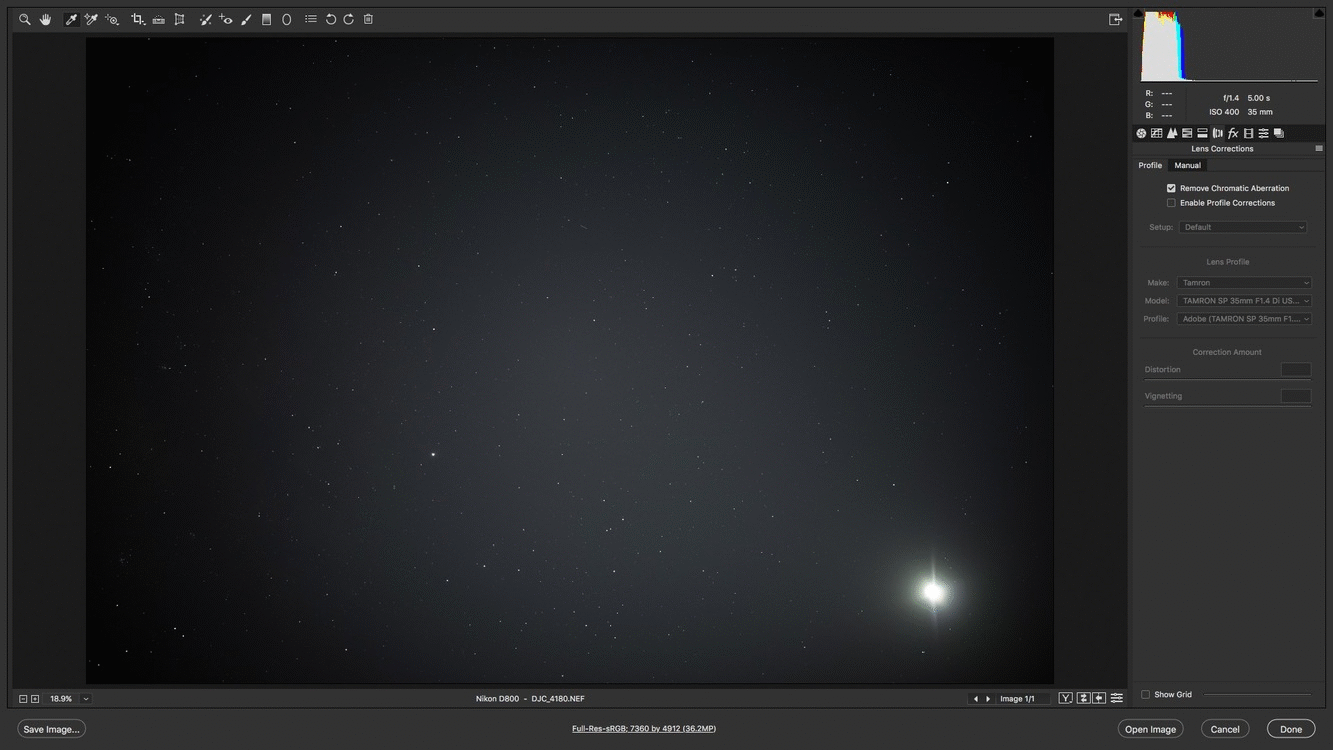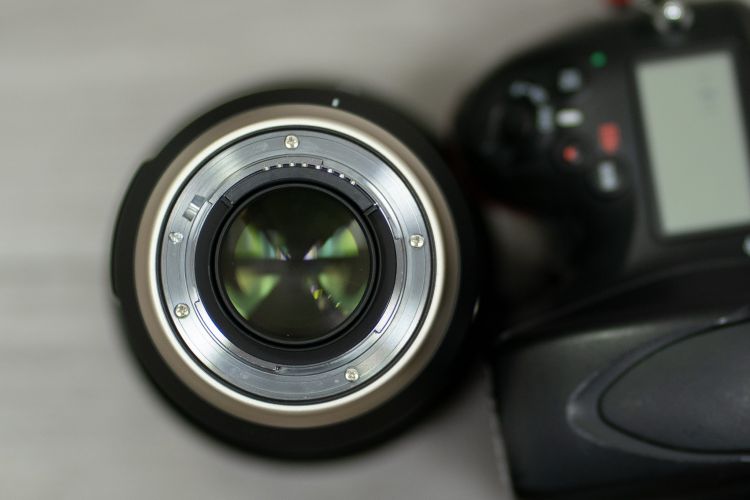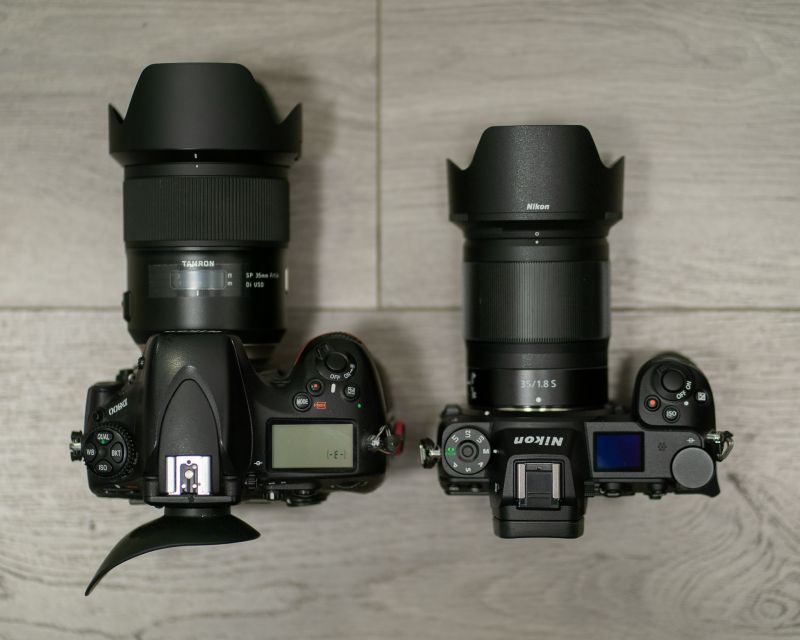
Tamron surprised us all when they announced their latest flagship full-frame lens: a 35mm f/1.4 prime, made for DSLRs.
Cranking out amazing f/2.8 zooms left and right for years now, (for both DSLR and mirrorless systems) they have shown their commitment to serious photographers with truly impressive lenses. Meanwhile, however, other third-party brands were cranking out impressive f/1.4 primes, too.
Now, the Tamron SP 35mm f/1.4 Di USD is the first f/1.4 prime lens they’ve ever made, to the best of my knowledge. So, you might assume that it’s just an experiment to “dip their toes” into the highly competitive realm of f/1.4, however, you would be totally wrong. Tamron has made a bold statement with this lens: here’s the new champion of affordable (flagship, even) 35mm primes!
Specifications
 Tamron SP 35mm f/1.4, Nikon D800 (Background: Nikon Z7, Z 35mm f/1.8 S)
Tamron SP 35mm f/1.4, Nikon D800 (Background: Nikon Z7, Z 35mm f/1.8 S)
Focal Length & Angle of View: 35mm, 63 degrees
Mounts: Nikon F, Canon EF (DSLR)
Price: $899 MSRP
Aperture & range: 9-blade circular, f/1.4-16
Optical Construction: 14 elements in 10 groups, 3 aspherical, 4 LD (low dispersion), BBAR-G2 coating (Broad-Band Anti-Reflection Generation 2), fluorine coating
Autofocus: USD (ultrasonic silent drive), “dynamic rolling cam”
Manual Focus: Mechanical, focus distance scale, no hyperfocal markings
Mechanical Construction: Metal, Plastic, rubber gaskets / weather sealing
Magnification & focus distance: 1:5, 0.3m (11.8″)
Size: 104x81mm
Weight: 805-815g (28.4-28.7 oz) Nikon/Canon
Filter Threads & Hood: 72mm, hood w/ spring-loaded lock
Included Accessories: Hood, Caps, Pouch
Price: $899 (Buy on B&H, Adorama, & Amazon)
Tamron SP 35mm f/1.4 Di USD | Who Should Buy It
 Tamron SP 35mm f/1.4, Nikon D800 | 1/1600, f/1.4, ISO 100
Tamron SP 35mm f/1.4, Nikon D800 | 1/1600, f/1.4, ISO 100
(Yes, you can photograph groups wide-open at f/1.4! Just line ’em up perfectly!)
35mm is one of the go-to focal lengths for experienced photographers who know exactly what angle of view they want for anything from candid journalism to editorial portraits.
There’s something about that slightly-wider-than-50mm angle of view that is perfect for an environmental portrait, or any sort of in-the-action feeling imagery, without getting too wide that distortion becomes a serious issue at the edge of your frame.
 Tamron SP 35mm f/1.4, Nikon Z7 & FTZ Adapter | 1/125 sec, f/2.8, ISO 1600
Tamron SP 35mm f/1.4, Nikon Z7 & FTZ Adapter | 1/125 sec, f/2.8, ISO 1600
Simply put, portrait photographers, wedding photographers, casual or professional, should all try a 35mm at some point. There’s a very good chance that if you like 50mm, you might absolutely love 35mm.
For general travel photography, landscape photography, nightscapes, and other nature/outdoor photography, 35mm might compete with 28mm or 24mm for the title of “best lens for the job”. However, a 35mm is often a top choice for astro-landscape photographers who prefer to stitch high-megapixel panoramas, or travel & landscape photographers who prefer a traditional, medium-wide focal length that they can use for both landscapes and other types of travel portraiture, or in-your-face action shooting.
 Tamron SP 35mm f/1.4, Nikon D800 | 1/1000, f/1.4, ISO 100
Tamron SP 35mm f/1.4, Nikon D800 | 1/1000, f/1.4, ISO 100
Personally, as both a landscape and nightscape photographer, I’d want to own both a 24mm and a 35mm f/1.4 prime. (If Tamron has an SP 24mm f/1.4 up their sleeves that is as good as this 35mm, I’ll be over the moon!)
But, why the Tamron 35mm f/1.4 in particular, out of all the other 35mm primes? It’s $899, and it’s not exactly ultralight, so it’s a pretty serious optic. There are also a lot of great 35mm f/1.8’s out there, which cost about the same or less, and fit a more portable form factor. (Including Tamron’s own 35mm f/1.8 VC!)
Simply put, the Tamron SP 35 is better. It’s not just significantly sharper than almost every other 35mm out there, it’s got a whole lot else going for it, which we’ll get into when we break down the image quality. Suffice it to say, it’s other things like color, bokeh, and everything else which make up the ambiguous aspect of “character” that images have.
In other words, this is a lens that discerning artists will choose for its special “look”, and pixel-peeping camera geeks will also choose for its more quantifiable aspects of performance.
tamron SP 35mm f/1.4 Di USD | Pros
 Tamron SP 35mm f/1.4, Nikon D800 | 1/400, f/1.4, ISO 100
Tamron SP 35mm f/1.4, Nikon D800 | 1/400, f/1.4, ISO 100
Image Quality
I have to be honest, I really don’t like to call something “perfect” in a gear review. But lately, it seems that I’ve been reviewing quite a few near-perfect lenses. Are any of them truly flawless, though? No, they could always be a little better. But, there is an optimal balance between “truly flawless” and “near-perfection”.
Unlike some of the other f/1.4 (and now even f/1.2) lenses out there which strive for optical perfection, (but still don’t achieve it, though they come close) …this Tamron is among those few lenses which seem to achieve the impossible: it’s not just optically better in most ways than its near-perfect competition, it also does it for less money and/or in a smaller form factor.
Sharpness
 Tamron SP 35mm f/1.4, Nikon D800 | 1/500, f/1.4, ISO 100
Tamron SP 35mm f/1.4, Nikon D800 | 1/500, f/1.4, ISO 100
 100% crop, center, f/1.4, 36 megapixels (Fine radius sharpening applied)
100% crop, center, f/1.4, 36 megapixels (Fine radius sharpening applied)
How can I put this? It’s shockingly good, indeed nearly perfect. We’re still collecting official comparison samples from a complete set of all the latest and most popular 35mm primes, however, I can say from experience over the past year that this lens is sharper than anything else I’ve tested, including all three of the new f/1.8 (mirrorless) 35mm’s.
For now, here’s the 100% crop sharpness test you all want to see: The Tamron SP 35mm f/1.4 versus the Sigma 35mm f/1.4 Art…

The center, and almost the entire image, is tack-sharp at f/1.4. Even on a high-megapixel camera, f/1.4 is already nearly as sharp as f/2.8.
Oh, and the center of the Tamron at f/1.4 is roughly equal to, or better than, the Sigma at f/2.8. (Yes, I re-did this test three times, I had to be sure!)
The edges and near-corners offer almost identical sharpness as the dead-center, and indeed the “realm of awesome sharpness” is enormous. See the graphic below to get a general idea of just how much of the image you can expect to achieve great sharpness in when shooting wide open, or near-perfect sharpness at f/2:


The extreme, extreme corners are still very good at f/1.4, and although a bit softer than the center, they somehow avoid chromatic aberration and coma/astigmatism almost entirely. We’ll get to those extreme corners in a bit. The bottom line? Here the Sigma 3 Art shows its softness, plus a slight bit of field curvature, which the Tamron doesn’t seem to have!
Colors & Contrast
 Tamron SP 35mm f/1.4, Nikon D800 | 1/125, f/1.4, ISO 100
Tamron SP 35mm f/1.4, Nikon D800 | 1/125, f/1.4, ISO 100
Vibrant, punchy colors, no sign of a dreaded third-party color cast, and generally crystal clear images are what come out of this lens. I’ll let the images do the talking on this one. Editing has been done in Adobe Lightroom.
 Tamron SP 35mm f/1.4, Nikon D800 | 1/800, f/2, ISO 100
Tamron SP 35mm f/1.4, Nikon D800 | 1/800, f/2, ISO 100
 Tamron SP 35mm f/1.4, Nikon D800 | 5 sec, f/1.4, ISO 400
Tamron SP 35mm f/1.4, Nikon D800 | 5 sec, f/1.4, ISO 400
Vignetting, Distortion, Flare

Vignetting is noticeable, but thankfully rather gradual and flattering for most types of subjects.
It’s significant at f/1.4 and f/2 for astrophotography, but the incredible sharpness makes up for it, in my opinion.

See an example of just how dark your image CAN be, if under-exposed to begin with. (The brighter image is with the lens correction profile activated)
So, definitely make sure you expose your images correctly, and use a lens profile (already available in Adobe Camera Raw) to handle vignetting and any faint distortion…
Flare and distortion are almost nonexistent. Tamron has definitely developed some high-quality lens coatings that are on par with any exotic name brand!
Bokeh & DOF
 Tamron SP 35mm f/1.4, Nikon D800 | 1/500, f/1.4, ISO 100
Tamron SP 35mm f/1.4, Nikon D800 | 1/500, f/1.4, ISO 100
These incredibly subjective aspects of image quality are always difficult to describe in written form. Again, I’d rather let the sample images do the talking.
 100% Crops, f/1.4, 36 megapixels (Fine radius sharpening applied)
100% Crops, f/1.4, 36 megapixels (Fine radius sharpening applied)
To me, the images look beautiful. Despite being optically complex, bokeh characteristics are incredibly smooth and creamy.
Sunstars
As with most modern portrait lenses that have been optimized for sharpness and/or bokeh rendition, sunstars on the Tamron SP 35mm f/1.4 are not the gorgeous, classic pin-sharp starbursts we used to get from older fast-aperture lenses that didn’t have fancy rounded aperture blades.
 Yes, that sunstar begins to appear immediately at f/1.6!
Yes, that sunstar begins to appear immediately at f/1.6!
100% Crop, 36 megapixels (Fine radius sharpening applied)
HOWEVER, upon close inspection (pixel-peeping) of cityscape image samples at 100%, I noticed something pretty impressive: While very large points of light weren’t offering up prominent sunstars until f/8-16, to my amazement I found that teeny-tiny, ultra-bright pin-point lights actually started forming sunstars upon stopping down just 1/3 stop to f/1.6.
That’s unprecedented. I’m not sure exactly how it will play out in real-world shooting, but I’m really excited to see more images from this lens in the hands of die-hard cityscape/nightscape photographers!
Color Aberration, Coma, Astigmatism, & Field Curvature



Where this lens truly sets itself apart from the competition is in this final aspect of image quality. Simply put, most lenses drop the ball here, especially those lenses which are optimized for portraits and bokeh.
Indeed, this is also where the Tamron steps ahead of the competition, once again. Color fringing/aberration and coma/astigmatism are impressively near-zero, which is very important when photographing certain things like nightscapes or cityscapes.
Even more important for nightscapes is field curvature, or a lack thereof. Once again, it’s near-zero on the Tamron, (see above) which is (yes, I’m over-using the word) unprecedented for a lens in this price range.
Macro Ability
 Tamron SP 35mm f/1.4, Nikon D800 | 1/500, f/1.4, ISO 100
Tamron SP 35mm f/1.4, Nikon D800 | 1/500, f/1.4, ISO 100
Last but not least, here’s one thing that is a perk of quite a few modern 35mm and 50mm prime lenses: they can focus quite close, and they don’t lose any of their amazing sharpness even when set to their closest distance. The Tamron SP 35mm’s actual magnification may not qualify it as an official macro lens, but the ultra-shallow DOF is more than enough for beautiful close-up photography, for most photographers.
When you focus this close, you absolutely “destroy” your background with buttery bokeh, and it’s a thing of beauty to see. Of all the modern prime lenses that are criticized for being “too clinical” due to their high resolution, the Tamron’s characteristics of how in-focus subjects (the plane of focus) roll-off to blur are what will set it apart from the competition.
Pro: Durability & hANDLING
 Metal mount, metal barrel, weather-sealing gaskets. This lens is professional!
Metal mount, metal barrel, weather-sealing gaskets. This lens is professional!
To be honest, we’re getting pretty accustomed to third-party lenses being rather robust and solid these days. That’s a very welcome experience, however, I still look closely and try to get a feel for the actual strength and feel of any new gear that gets sent my way. Just because a lens is heavy, doesn’t mean it’s well-engineered and durable.
Tamron was known in the past for focusing more on lightweight materials and construction, sometimes at the expense of durability or practical handling. However, that has changed completely with many of their latest lenses, especially their G2 zooms. Not only are they well-engineered to operate intuitively and smoothly, they’re built to be rugged and stand the test of time just as well as any name-brand optic.
Pro: Autofocus RELIABILITY (WHEN CALIBRATED)
 Tamron SP 35mm f/1.4, Nikon D800 | 1/320, f/1.4, ISO 400
Tamron SP 35mm f/1.4, Nikon D800 | 1/320, f/1.4, ISO 400
It has also been a long journey for third-party lenses to be able to truly match the autofocus speed and reliability of name brands. Yet again, Tamron’s latest SP and G2 lenses have all proven that they’re up to the task.
That is, DSLR systems all use an autofocus method that can be prone to unreliable results if the micro-adjustment is off, for either the body or the lens.
It used to be that third-party lenses were indeed much worse at consistently nailing focus than name brands. Now, however, any difference that may still exist is nearly impossible to discern from the general shortcoming of optical phase-detection autofocus itself.
In other words, if you’re a DSLR user, it doesn’t matter if you buy name-brand or third-party lenses; you’ll have to learn how to calibrate those lenses either way.
Once you do learn how to calibrate your lenses, though, you’ll actually find that third parties such as Tamron offer a really cool perk in the form of a USB dock that allows you to perform quite a lot of customization that the name brands don’t even have.
Tamron’s USB dock is called the TAP-in Console, and it’s available for both Canon and Nikon. For just $59, you can make advanced focusing adjustments, stabilization adjustments if the lens has VC, and other things such as firmware updating for continued compatibility with future bodies and systems.
Pro: Value
 …Wait a minute, where’s the aperture tab? Praise the Lord, it’s like Nikon “E” lenses!!!
…Wait a minute, where’s the aperture tab? Praise the Lord, it’s like Nikon “E” lenses!!!
At $899, this is not a “cheap” third-party alternative. Over the last 5+ years, Tamron has joined the ranks of the third parties who aspire to not just create budget-friendly alternatives for beginners who are just buying their first aftermarket lens, but also create strong temptations for high-end professionals.
If $900 is totally out of your price range, then it’s hard to see “value” listed as pro instead of seeing “price” listed as a con. Trust me, though, with this flagship optic, the value is that impressive. If you’re looking to save a few hundred bucks, there’s a handful of options out there in the
tamron SP 35mm f/1.4 Di USD | Cons
 Careful of that rear element, it’s easy to scratch accidentally!
Careful of that rear element, it’s easy to scratch accidentally!
When a third-party lens maker comes out with a high-end lens, it’s really hard to be critical because they repeatedly deliver the goods. Not only do they achieve great image results at a fair price, they often toss in a few additional perks that even the name-brand options in a similar price range might not offer.
This is exactly the case with the Tamron 35mm f/1.4. It’s hard to nit-pick about this lens. None of these cons are likely to stop you from deciding to buy it.
Con: Autofocus Calibration Required (A DSLR problem)
The first issue that always comes up when reviewing new DSLR lenses, especially from third-party makers, is autofocus compatibility and reliability. There’s just no escaping the fact that sometimes, lenses need to be calibrated to whichever body they’re going to be used on.
This isn’t Tamron’s problem specifically, it’s a huge issue for all third-party lens makers, and it’s even a common frustration for native, name-brand lenses too.
For me as a gear reviewer and full-time photographer, I’ve gotten used to checking for AF micro-adjustment whenever I get a new lens or a new body. Sure enough, the Tamron needed about -10 to get autofocus working perfectly.
I’m not going to hold this against Tamron or this lens in particular, though, it’s just something I want to remind all DSLR shooters to consider whenever they’re getting new gear, or heavily abusing their gear every month.
Because, the fact is, when calibrated properly you can really trust this lens to nail focus, and that’s impressive for any prime on a DSLR.
Con: Weight & Size
 Tamron SP 35mm f/1.4, Nikon D800 | Nikon Z7, Z 35mm f/1.8 S
Tamron SP 35mm f/1.4, Nikon D800 | Nikon Z7, Z 35mm f/1.8 S
If you’re shopping for a prime lens because you want incredible image quality at fast, wide-open apertures, then you already know your best lenses aren’t going to be in the “ultralight” category.
If you’re this type of photographer, then the Tamron SP 35mm f/1.4 is absolutely worth its substantial size and heft.
It’s about the size and weight of the Canon 35mm f/1.4 mk2, which is just slightly larger than the Sigma 35mm f/1.4 Art. On a bigger DSLR, it feels absolutely massive compared to most mirrorless options.
However, some people do shop for primes because they want portability; they care less about how sharp a prime is versus an f/2.8 zoom; really what they want is the lightest, smallest possible lens that still has decent image quality after stopping the aperture down a stop or two.
If you’re this type of photographer, then you might consider an alternative, as there are indeed a couple of ultralight 35mm primes for both Canon and Nikon that you can choose from.
(What type of photographer are YOU? We’d really love to know, please leave a comment!)
tamron SP 35mm f/1.4 Di USD | Compared To The Competition

OK, first there’s the obvious comparison, that is, everybody wants to know how this flagship-grade Tamron 35mm f/1.4 compares against the other third-party 35mm f/1.4 flagship, the Sigma 35mm f/1.4 Art.
To get right to the point: the Sigma puts up a very good fight, but, at nearly 7 years old, …it didn’t stand a chance on today’s modern 40+ megapixel cameras. The Tamron is clearly a modern lens that is ready for today’s and tomorrow’s best camera bodies.
Just for fun, though, how does the $899 Tamron compare against a $1799 Canon 35mm f/1.4 L mk2, the modern marvel of name-brand SLR lenses?
It fares shockingly well, actually. It’s a classic example of a ~10% difference in performance, at a +100% difference in price. But, since I don’t even know if you’ll believe me, I’ll go straight to the source of the most thorough, reliable lens tests (for sharpness) around, LensRentals.com:
 Canon EF 35mm f/1.4 L mk2 MTF versus Tamron SP 35mm f/1.4 MTF
Canon EF 35mm f/1.4 L mk2 MTF versus Tamron SP 35mm f/1.4 MTF
(Thank you, Roger Cicala, for giving us pixel-peepers the gift of OLAF!)
Yes, Canon L lenses are known for having “that look”, a combination of beautiful colors, popping contrast, and buttery bokeh. But, the Tamron has a beautiful overall rendering of images, too!
If anything, the Tamron achieves more of the impossible: the images have got “character”, and yet it still wins for sharpness against anything that LensRentals has pitted it against thus far.
Translation: if you’re looking for that elusive balance between sheer resolving power and “that look” of character to bokeh and colors, the Tamron is a unicorn of an exotic lens, without the usual price tag or massive heft of most “trophy” lenses.
It’s still a bit heavy, though. If you’re looking for something slightly more portable, a Canon shooter might opt for the 35mm f/2 IS USM, or a Nikon shooter might opt for the AF-S 35mm f/1.8 G ED, or even the old 35mm f/2 AF-D, even though none of those lenses come close to matching the Tamron’s optics.
Of course, both Canon and Nikon shooters can consider the Tamron 35mm f/1.8 VC, (the only way a Nikon shooter can get a stabilized 35mm prime!) …but again, the slightly more portable f/1.8 Tamron is not an optical match for the f/1.4 Tamron.
All in all, if you want the best, the Tamron SP 35mm f/1.4 is it. If you’ve already got the Sigma 35 1.4 Art, you probably already know whether you’re still happy with its solid performance, …or if you’re ready for the new 35mm champion.
tamron SP 35mm f/1.4 Di USD Review | Conclusion

I’ll be totally honest: the strongest feeling I’m left with after shooting with the Tamron 35mm f/1.4 is, “where was this lens 5 years ago, when DSLRs were still king of the hill?”
As someone who reviews camera gear 9-5, Mon-Fri, I spend most of my time working with new mirrorless systems now, and less time with DSLRs. That’s just the way it is. I actually love optical viewfinders, though, and would happily keep shooting with a Nikon D750; I might even buy a Nikon D760 if such a camera appears. This Tamron 35mm would be my absolute top choice for it, or any DSLR system. Yet, I already feel like my future is (mostly) a mirrorless one…
Then again, I can’t help but also ask myself, “if Tamron can do this for the small, now-outdated Nikon F-mount, …what could they accomplish when they are able to develop (autofocus) lenses for the new Nikon Z and Canon RF mounts?
Indeed, Tamron’s lenses made for Sony’s FE E-mount are proving to be shockingly good, and they’re already teasing that more are coming! I for one hope they’re working on some f/1.4 primes for all three mirrorless mounts. (Of course, there’s always adapters!)
But, I digress. For those photographers who do have a DSLR, there’s no question: this is the best 35mm prime lens you’ll ever see anywhere near the $1,000 price range. It matches name-brand 35mm lenses that cost as much, or more than twice as much. It destroys other affordable primes, both name-brand and third-party. It’s not obscenely heavy or large, but it’s also built to solid, professional standards.
So while a truly casual, lightweight shooter might prefer an equally unique optic like the Tamron 35mm f/1.8 VC, with its optical stabilization, any photographer who is shopping for the best dang 35mm prime around, the Tamron SP 35mm f/1.4 Di USD is the best investment.
Purchase Options:
$899 (Buy on B&H, Adorama, & Amazon)
9.5 Score
Pros
- Incredible Sharpness & Overall Image Quality
- Flagship grade construction and durability
- Professionally reliable autofocus performance
- Value compared to all other flagship competitors
Cons
- Portability (Mirrorless version, please!)
Final Verdict
This lens is perfect in every way, except maybe for the fact that it's only available (natively) for DSLRs. Having said that, this is still the best 35mm prime around, by a huge margin in most comparisons, no matter what full-frame mount you're shooting on.
Matthew Saville
Follow his wilderness nightscape adventures on Instagram: instagram.com/astrolandscapes




Get Connected!